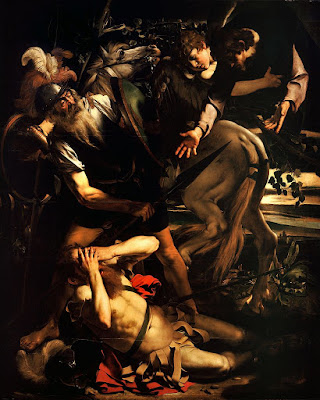 |
| Caravaggio Bacchus (also called Sick Bacchus or Self Portrait as Bacchus) ca. 1593 oil on canvas Galleria Borghese, Rome |
 |
| Caravaggio Sleeping Cupid ca. 1600 oil on canvas Palazzo Pitti, Florence |
 |
| Caravaggio Narcissus ca. 1598 oil on canvas Palazzo Barberini, Rome |
 |
| Caravaggio St John the Baptist ca. 1610 oil on canvas Galleria Borghese, Rome |
 |
| Caravaggio St John the Baptist 1602 oil on canvas Pinacoteca Capitolina, Rome |
 |
| Caravaggio St John the Baptist ca. 1604 oil on canvas Palazzo Corsini, Rome |
 |
| Caravaggio St Jerome in his Study ca. 1606 oil on canvas Galleria Borghese, Rome |
 |
| Caravaggio St Matthew and the Angel ca. 1602 oil on canvas Contarelli Chapel Chiesa di San Luigi dei Francesi, Rome |
 |
| Caravaggio Entombment of Christ 1603-1604 oil on canvas Pinacoteca Vaticana, Rome |
 |
| Caravaggio Conversion of St Paul ca. 1600-1601 oil on canvas Cerasi Chapel Basilica di Santa Maria del Popolo, Rome |
 |
| Caravaggio Conversion of St Paul ca. 1600 oil on canvas Odescalchi Balbi Collection, Rome |
 |
| Caravaggio David with the Head of Goliath (self portrait as Goliath) 1610 oil on canvas Galleria Borghese, Rome |
 |
| Caravaggio Martyrdom of St Matthew ca. 1599-1600 oil on canvas Contarelli Chapel Chiesa di San Luigi dei Francesi, Rome |
 |
| Caravaggio Madonna dei Palafrenieri 1606 oil on canvas Galleria Borghese, Rome |
 |
| Caravaggio The Fortune Teller ca. 1594-95 oil on canvas Pinacoteca Capitolina, Rome |
"Caravaggio is the prototype of the turbulent Bohemian artist, his explosive personality helping to obscure the traditional elements of his painting. It is now obvious, however, that from c. 1599 he drew on High Renaissance and even antique models, and that his decorum-defying naturalism derived from Flemish art mediated through Veneto-Lombard painting of the early 16th century (Lotto, Moretto, Romanino, Savoldo). . . . Whether from inadequate training or aesthetic preference, Caravaggio confined himself to painting in oils, in a narrow range of earth colours, even in his large-scale Roman chapel decorations. . . . Caravaggio's œuvre, from the suave homoerotic paintings of the 1580s through the tragic visions of 1606-10, is distinguished by its directness of address to the viewer, accomplished in his youth through mastery of close-range illusionism, later through selective social realism and the expressive manipulation of light. These qualities may compensate for his shortcomings in the composition of large-scale narrative, but do not disguise them."
– from the Yale Dictionary of Art and Artists by Erika Langmuir and Norbert Lynton (2000)